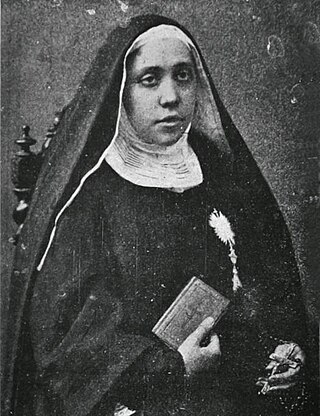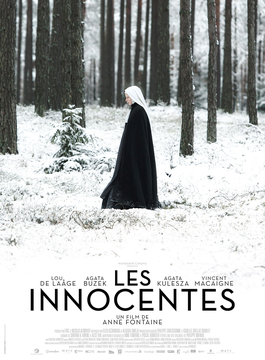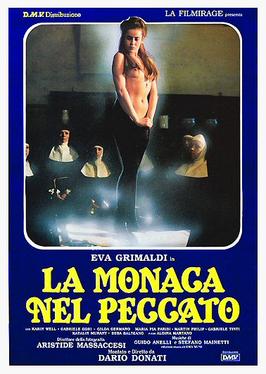Related Research Articles

Francesco II Gonzaga was the ruler of the Italian city of Mantua from 1484 until his death.
The women in prison film is a subgenre of exploitation film that began in the early 20th century and continues to the present day.

Mary of Jesus of Ágreda , OIC, also known as the Abbess of Ágreda, was a Franciscan abbess and spiritual writer, known especially for her extensive correspondence with King Philip IV of Spain and reports of her bilocation between Spain and its colonies in New Spain. She was a noted mystic of her era.

The Company of the Daughters of Charity of Saint Vincent de Paul, commonly called the Daughters of Charity or Sisters of Charity of Saint Vincent De Paul, is a Society of Apostolic Life for women within the Catholic Church. Its members make annual vows throughout their life, which leaves them always free to leave, without the need of ecclesiastical permission. They were founded in 1633 by Vincent de Paul and state that they are devoted to serving the poor through the corporal and spiritual works of mercy.

Nunsploitation is a subgenre of exploitation film which had its peak in Europe in the 1970s. These films typically involve Christian nuns living in convents during the Middle Ages.

Dark Habits is a 1983 Spanish black comedy film written and directed by Pedro Almodóvar and starring Julieta Serrano, Marisa Paredes and Chus Lampreave. The plot follows a cabaret singer who finds refuge in a convent of eccentric nuns, while the film is an exploration of the anachronistic situation of institutionalized religion in contemporary Spanish society.
Benedetta Carlini was an Italian Catholic nun who claimed to experience mystic visions. As abbess of the Convent of the Mother of God, at Pescia, she had a sexual relationship with one of her nuns, Sister Bartolomea. These came to the attention of the Counter-Reformation papacy, determined to subordinate potentially troublesome mystics if they showed any signs of heretical spirituality. Although they paid three to four visits to the nunnery, it was not until they interrogated Sister Bartolomea that they found that Benedetta and Bartolemea had engaged in sexual relations. Bartolomea gave testimony that Benedetta engaged in frottage with her while possessed by the spirit of a male demon known as Splenditello. Benedetta was stripped of her rank and imprisoned.

The Sanctuary of Our Lady of Arantzazu is a Franciscan sanctuary located in Oñati, Basque Country, Spain. The shrine is a much appreciated place among Gipuzkoans, with the Virgin of Arantzazu being the sanctuary's namesake and patron saint of the province along with Ignatius of Loyola.

Women in Cages is a 1971 women in prison sexploitation film directed by Gerardo de León and starring Jennifer Gan, Judy Brown, Roberta Collins, and Pam Grier. Co-produced by Roger Corman, it was prominently featured in the Planet Terror portion of the 2007 film Grindhouse. Grindhouse director Quentin Tarantino said of the film, "I'm a huge, huge fan of Gerry de Leon.... the film is just harsh, harsh, harsh." He described the final shot as one of "devastating despair".

The Big Doll House is a 1971 American women-in-prison film starring Pam Grier, Judy Brown, Roberta Collins, Brooke Mills, and Pat Woodell. The film follows six female inmates through daily life in a gritty, unidentified tropical prison. Later the same year, the film Women in Cages featured a similar story and setting and much the same cast, and was shot in the same abandoned prison buildings. A nonsequel follow-up, titled The Big Bird Cage, was released in 1972.

Mother Teresa: In the Name of God's Poor is a 1997 made-for-television biographical film directed by Kevin Connor and starring Geraldine Chaplin as Mother Teresa. Mother Teresa herself had approved the script but withdrew her imprimatur shortly before her death. It was broadcast on what was then known as The Family Channel on 5 October 1997.

Rani Maria Vattalil, FCC was an Indian Catholic religious sister and social worker in the Franciscan Clarists who worked in the Diocese of Indore. Vattalil, a Syro-Malabar Eastern Catholic, dedicated herself to catechetical formation and educational instruction in different areas of the region. She was vocal in matters of social justice, which led to her murder by those opposed to her aid of the poor.

Maria Cristina of the Immaculate Conception Brando, born Adelaida Brando, was an Italian saint, nun and the founder of the Congregation of the Sisters, Expiatory Victims of Jesus in the Blessed Sacrament, an international teaching institute. She was beatified by Pope John Paul II on 27 April 2003, and canonized by Pope Francis on 17 May 2015.

The Innocents, also known as Agnus Dei, is a 2016 drama film directed by Anne Fontaine, which features Lou de Laâge, Agata Kulesza, Agata Buzek and Vincent Macaigne in its cast. The script is by Sabrina B. Karine, Pascal Bonitzer, Anne Fontaine and Alice Vial, after an original idea by Philippe Maynial. Maynial took inspiration from the experiences of his aunt, Madeleine Pauliac, a French Red Cross doctor who worked in Poland after World War II.

The Other Hell is a 1981 Italian horror film written and directed by Bruno Mattei and Claudio Fragasso and starring Franca Stoppi and Carlo De Mejo.

On December 2, 1980, four Catholic missionaries from the United States working in El Salvador were raped and murdered by five members of the El Salvador National Guard. The murdered missionaries were Maryknoll Sisters Maura Clarke and Ita Ford, Ursuline Dorothy Kazel, and lay missionary Jean Donovan.

Convent of Sinners, is a 1986 Italian nunsploitation erotic film directed by Joe D'Amato. D'Amato directed, photographed and edited the film. The Rene Rivet screenplay was based on the novel "La Religeuse" by Denis Diderot.
Maria Giovanna Fasce was an Italian Roman Catholic professed religious of the Augustinian nuns in the religious name of "Maria Teresa". Fasce served in various leadership positions in her convent in Genoa and was noted for the establishment of an orphanage and spreading the charism of Saint Augustine and Saint Rita of Cascia.
María de San Antonio Lorenzo y Fuentes or Sor María de San Antonino was a Dominican religious sister and Spanish mystic.
María Francisca Ricart Olmos, religious name María Guadalupe, was a Spanish nun of the Servite Order. Ricart's call to the religious life manifested at the time she made her First Communion after expressing the desire to consecrate herself to God; she entered the convent when she turned fifteen and served her convent as both a prioress and mistress of novices. Her peers held her in high regard for her dedication to helping and instructing the novices] as well as for her compassionate and jovial character.